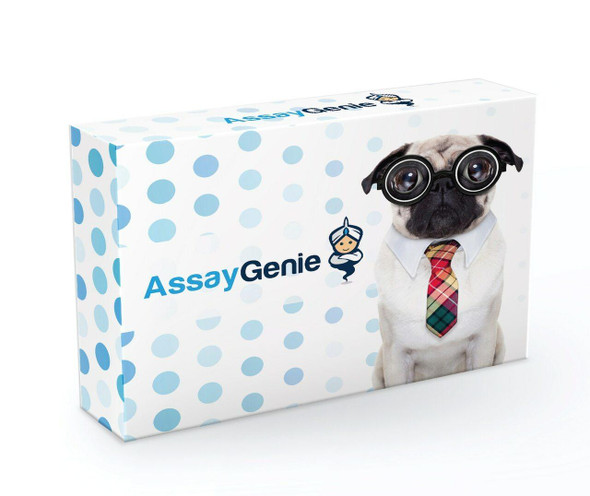ANGPTL4 Antibody, FITC conjugated (PACO64041)
- SKU:
- PACO64041
- Product type:
- Antibody
- Reactivity:
- Human
- Host Species:
- Rabbit
- Isotype:
- IgG
- Application:
- ELISA
- Antibody type:
- Polyclonal
- Conjugation:
- FITC
Frequently bought together:
Description
| Antibody Name: | ANGPTL4 Antibody?FITC conjugated (PACO64041) |
| Antibody SKU: | PACO64041 |
| Size: | 50ul |
| Host Species: | Rabbit |
| Tested Applications: | ELISA |
| Recommended Dilutions: | |
| Species Reactivity: | Human |
| Immunogen: | Recombinant Human Trefoil factor 3 protein (26-406AA) |
| Form: | Liquid |
| Storage Buffer: | Preservative: 0.03% Proclin 300 Constituents: 50% Glycerol, 0.01M PBS, pH 7.4 |
| Purification Method: | >95%, Antigen Affinity purified & Affinity purified |
| Clonality: | Polyclonal |
| Isotype: | IgG |
| Conjugate: | FITC |
| Background: | Protein with hypoxia-induced expression in endothelial cells. May act as a regulator of angiogenesis and modulate tumorigenesis. Inhibits proliferation, migration, and tubule formation of endothelial cells and reduces vascular leakage. May exert a protective function on endothelial cells through an endocrine action. It is directly involved in regulating glucose homeostasis, lipid metabolism, and insulin sensitivity. In response to hypoxia, the unprocessed form of the protein accumulates in the subendothelial extracellular matrix (ECM). The matrix-associated and immobilized unprocessed form limits the formation of actin stress fibers and focal contacts in the adhering endothelial cells and inhibits their adhesion. It also decreases motility of endothelial cells and inhibits the sprouting and tube formation (By similarity). |
| Synonyms: | Angiopoietin-related protein 4 (Angiopoietin-like protein 4) (Hepatic fibrinogen/angiopoietin-related protein) (HFARP), ANGPTL4, ARP4 HFARP PGAR |
| UniProt Protein Function: | ANGPTL4: Protein with hypoxia-induced expression in endothelial cells. May act as a regulator of angiogenesis and modulate tumorigenesis. Inhibits proliferation, migration, and tubule formation of endothelial cells and reduces vascular leakage. May exert a protective function on endothelial cells through an endocrine action. It is directly involved in regulating glucose homeostasis, lipid metabolism, and insulin sensitivity. In response to hypoxia, the unprocessed form of the protein accumulates in the subendothelial extracellular matrix (ECM). The matrix-associated and immobilized unprocessed form limits the formation of actin stress fibers and focal contacts in the adhering endothelial cells and inhibits their adhesion. It also decreases motility of endothelial cells and inhibits the sprouting and tube formation. |
| UniProt Protein Details: | Protein type:Inhibitor; Apoptosis; Secreted, signal peptide; Secreted; Extracellular matrix Chromosomal Location of Human Ortholog: 19p13.3 Cellular Component: proteinaceous extracellular matrix; extracellular space; extracellular region Molecular Function:enzyme inhibitor activity; protein binding Biological Process: positive regulation of angiogenesis; response to hypoxia; negative regulation of lipoprotein lipase activity; cellular lipid metabolic process; angiogenesis; cell differentiation; protein homooligomerization; negative regulation of apoptosis Disease: Plasma Triglyceride Level Quantitative Trait Locus |
| NCBI Summary: | This gene encodes a glycosylated, secreted protein containing a C-terminal fibrinogen domain. The encoded protein is induced by peroxisome proliferation activators and functions as a serum hormone that regulates glucose homeostasis, lipid metabolism, and insulin sensitivity. This protein can also act as an apoptosis survival factor for vascular endothelial cells and can prevent metastasis by inhibiting vascular growth and tumor cell invasion. The C-terminal domain may be proteolytically-cleaved from the full-length secreted protein. Decreased expression of this gene has been associated with type 2 diabetes. Alternative splicing results in multiple transcript variants. This gene was previously referred to as ANGPTL2 but has been renamed ANGPTL4. [provided by RefSeq, Sep 2013] |
| UniProt Code: | Q9BY76 |
| NCBI GenInfo Identifier: | 25008123 |
| NCBI Gene ID: | 51129 |
| NCBI Accession: | Q9BY76.2 |
| UniProt Secondary Accession: | Q9BY76,Q53HQ6, Q53HU1, Q6UXN0, Q9HBV4, Q9NZU4, Q9Y5B3 A8MY84, B4E089, D6W670, F5H0I2, |
| UniProt Related Accession: | Q9BY76 |
| Molecular Weight: | 26,853 Da |
| NCBI Full Name: | Angiopoietin-related protein 4 |
| NCBI Synonym Full Names: | angiopoietin-like 4 |
| NCBI Official Symbol: | ANGPTL4 |
| NCBI Official Synonym Symbols: | NL2; ARP4; FIAF; HARP; PGAR; HFARP; TGQTL; UNQ171; pp1158; ANGPTL2 |
| NCBI Protein Information: | angiopoietin-related protein 4; fasting-induced adipose factor; PPARG angiopoietin related protein; hepatic angiopoietin-related protein; hepatic fibrinogen/angiopoietin-related protein; peroxisome proliferator-activated receptor (PPAR) gamma induced angiopoietin-related protein |
| UniProt Protein Name: | Angiopoietin-related protein 4 |
| UniProt Synonym Protein Names: | Angiopoietin-like protein 4; Hepatic fibrinogen/angiopoietin-related protein; HFARP |
| Protein Family: | Angiopoietin-related protein |
| UniProt Gene Name: | ANGPTL4 |
| UniProt Entry Name: | ANGL4_HUMAN |










